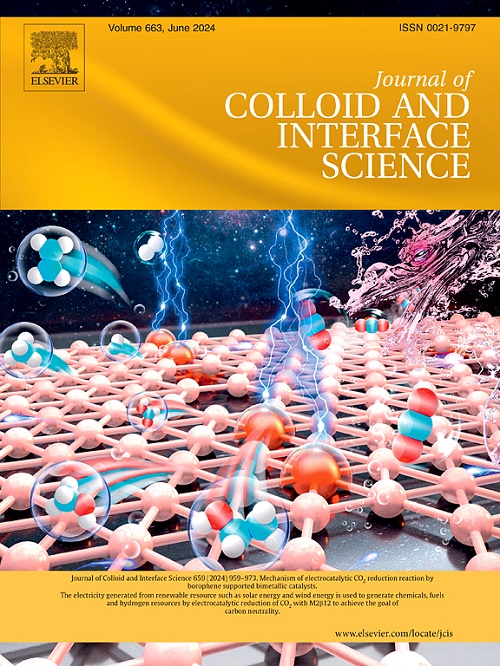Alkoxy functionalized covalent organic frameworks for efficient oil/water separation
IF 9.7
1区 化学
Q1 CHEMISTRY, PHYSICAL
引用次数: 0
Abstract
The massive discharge of oily wastewater and the frequent occurrence of oil spills have posed serious threat to human. Hence, it is important to develop functional materials and related methods to achieve efficient oil/water separation. Herein, a new superhydrophobic COF (named SCOF) was designed and successfully synthesized with functional alkoxy side chains at room temperature for the first time and was then applied to oil/water separation. By loading SCOF onto the fabric, the prepared superhydrophobic Fabric@SCOF membrane could effectively separate different oil/water mixtures, and the separation efficiency was higher than 99 %. Noteworthy, when separating immiscible CH2Cl2/water mixture, the maximum oil flux was 63,129 L m−2 h−1 and the separation efficiency reached 99.8 %. To the best of our knowledge, this was the highest oil flux of superhydrophobic COF-based membrane prepared on the fabric substrate for the separation of immiscible oil/water mixture only in gravity. By loading SCOF onto porous melamine sponge, the fabricated Sponge@SCOF could adsorb different oils, and the adsorption capacity for CCl4 could reach 151 g/g. This work provides insights for the design and synthesis of novel functional COFs, and broadens the application of COF-based superhydrophobic composite in oil/water separation, which is of great significance for oily wastewater treatment and environmental remediation.

用于油水高效分离的烷氧基功能化共价有机骨架
含油废水的大量排放和石油泄漏事故的频繁发生对人类构成了严重的威胁。因此,开发功能材料和相关方法来实现高效的油水分离是非常重要的。本文首次设计并在室温下成功合成了一种具有功能烷氧侧链的超疏水COF (SCOF),并将其应用于油水分离。将SCOF加载到织物上,制备的超疏水Fabric@SCOF膜可以有效地分离不同的油水混合物,分离效率高于99%。值得注意的是,在分离CH2Cl2/水非混相混合物时,最大油通量为63,129 L m−2 h−1,分离效率达到99.8%。据我们所知,这是织物衬底上制备的超疏水cof基膜的最高油通量,仅在重力下分离不混相的油/水混合物。将SCOF加载到多孔三聚氰胺海绵上,制备的Sponge@SCOF可以吸附不同的油脂,对CCl4的吸附量可达151 g/g。本研究为新型功能性COFs的设计和合成提供了思路,拓宽了COFs基超疏水复合材料在油水分离中的应用,对含油废水处理和环境修复具有重要意义。
本文章由计算机程序翻译,如有差异,请以英文原文为准。
求助全文
约1分钟内获得全文
求助全文
来源期刊
CiteScore
16.10
自引率
7.10%
发文量
2568
审稿时长
2 months
期刊介绍:
The Journal of Colloid and Interface Science publishes original research findings on the fundamental principles of colloid and interface science, as well as innovative applications in various fields. The criteria for publication include impact, quality, novelty, and originality.
Emphasis:
The journal emphasizes fundamental scientific innovation within the following categories:
A.Colloidal Materials and Nanomaterials
B.Soft Colloidal and Self-Assembly Systems
C.Adsorption, Catalysis, and Electrochemistry
D.Interfacial Processes, Capillarity, and Wetting
E.Biomaterials and Nanomedicine
F.Energy Conversion and Storage, and Environmental Technologies

 求助内容:
求助内容: 应助结果提醒方式:
应助结果提醒方式:


